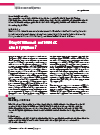Author page: Igor Kalyaev
Artificial Intelligence and Supercomputing Technologies
DOI: 10.33917/es-2.194.2024.42-53
While the physical basis of natural intelligence is the human brain, the physical basis of artificial intelligence (AI) is constituted by computers. Currently, the processes of creating AI based on computer technology are developing in two main directions — logical direction and neuromorphic one. The logical approach is aimed at creating computer systems designed to solve one or a limited set of “intelligent” problems (that is, problems whose solution would require intelligence if they were solved by a person). The neuromorphic approach aims to create computer systems that imitate the human brain functioning, and ultimately to create its artificial analogue.
References:
1. Yangging Jia. Technical Report. No. VCB/EECS 2014-93, Berkley.
2. Kalyaev I.A., Levin I.I., Semernikov E.A., Shmoilov V.I. Reconfigurable Multipipeline Computing Structures. Nova Science Publishers, Inc. USA. 2012. 340 p.
3. Guzik V.F., Kalyaev I.A., Levin I.I. Rekonfiguriruemye vychislitel’nye sistemy [Reconfigurable Computing Systems]. Rostov n/D, Izd-vo YuFU, 2016, 472 p.
4. Kalyaev I.A., Levin I.I. Rekonfiguriruemye vychislitel’nye sistemy na osnove PLIS [Reconfigurable Сomputing Systems Based on FPGAs]. Rostov n/D, Izd-vo YuNTs RAN, 2022, 475 p.
5. Spall J., Guo X., Barrett T.D., Lvovsky A.I. Fully reconfigurable coherent optical vector-matrix multiplication. Optics Letters, 45, 5752–5755 (2020).
6. Tait A.N., de Lima T.F., et al. Neuromorphic photonic networks using silicon photonic weight banks. Scientific Reports, 7, 7430 (2017).
7. Shen Y., Harris N.C., et al. Deep learning with coherent nanophotonic circuits. Nature Photon, 11(7), pp. 441–446 (2017).
8. Golovastikov N.V., Dorozhkin P.S., Soyfer V.A. Intellektual’nye tekhnicheskie sistemy na osnove fotoniki [Intelligent Technical Systems Based on Photonics]. Ontology of Designing, 2021, vol. 11, pp. 422–436.
9. Mikhaylov A.N., Gryaznov E.G., Lukoyanov V.I., Koryazhkina M.N., Bordanov I.A., Shchanikov S.A., Tel’minov O.A., Ivanchenko M.V., Kazantsev V.B. Na puti k realizatsii vysokoproizvoditel’nykh vychisleniy v pamyati na osnove memristornoy elektronnoy komponentnoy bazy [Towards the Implementation of High-performance Computing in Memory Based on Memristor Electronic Components]. Fizmat, 2023, vol. 1, no 1, pp. 42–64, DOI: 10.56304/S0000000023010021
10. Mikhaylov A.N., Gryaznov E.G., Koryazhkina M.N., Bordanov I.A., Shchanikov S.A., Telminov O.A., Kazantsev V.B. Neuromorphic computing based on CMOS-integrated memristive arrays: current state and perspectives. Supercomputing Frontiers and Innovations, 2023, vol. 10, no 2, pp. 77–103, DOI: 10.14529/jsfi230206
11. Dongarra J. Less Moor, more Brain. Moskovskiy superkomp’yuternyy forum, MGU, 2019.
12. Iskusstvennyy intellekt uvelichil moshchnost’ Superkomp’yuternogo tsentra “Politekhnicheskiy”. Saint Petersburg, SPbPU Petra Velikogo, Nauka i innovatsii, 22 dekabrya 2023 g. [Artificial Intelligence Has Increased the Capacity of the Polytechnic Supercomputer Center. St. Petersburg, Peter the Great St. Petersburg Polytechnic University. Science and Innovation, December 22, 2023], available at: https://www.spbstu.ru/media/news/nauka_i_innovatsii/
iskusstvennyy-intellekt-uvelichil-moshchnost-superkompyuternogo-tsentra-politekhnicheskiy/
Artificial Intelligence: Whither Goest Thou?
DOI: 10.33917/es-5.163.2019.6-15
Biblical phrase “Quo vadis”, which means “where are you going,” was not accidentally put into the title of the article, because today some people consider artificial intelligence to be almost a kind of messiah who will save our world from all evils and adversities, while others believe that he is akin to the Horseman of the Apocalypse, who will completely destroy human civilization and turn all of us into machines’ slaves. The article analyses substantiation of these judgments.







